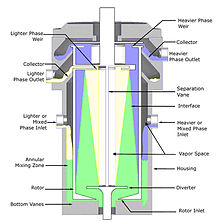- Centrifugal extractor
-
 Centrifugal extractor
Centrifugal extractor
A centrifugal extractor uses the rotation of the rotor inside a centrifuge to mix two immiscible liquids outside the rotor and to separate the liquids in the field of gravity inside the rotor. This way, a centrifugal extractor generates a continuous extraction from one liquid phase (fermentation broth) into another liquid phase (organic solvent).
Contents
History
Annular centrifugal extractor design and development has been pursued by various Department of Energy laboratories for more than 40 years. It has been employed in solvent extraction processes for metals valuable to the nuclear industry. Commercialization of this technology began in 1990 when a patent was granted for continuous separation of hydrocarbons from water (Meikrantz, 1990). In the past years the centrifuge design has been further improved and scaled up to flow rates of several hundred liters per minute (Meikrantz et al., 1997).
Cutaway view
The cutaway view shows the flow path of the respective liquids. Two immiscible liquids of different densities are fed to the separate inlets and are rapidly mixed in the annular space between the spinning rotor and stationary housing. The mixed phases are directed toward the center of the rotor by radial vanes in the housing base. As the liquids enter the central opening of the rotor, they are accelerated toward the wall. The mixed phases are rapidly accelerated to rotor speed and separation begins as the liquids are displaced upward.
Processing principles
The annular centrifugal contactors are low rounds-per-minute (rpm), moderate gravity enhancing (100–2000 G) machines, and can therefore be powered by a direct drive, variable speed motor. The effectiveness of a centrifugal separation can be easily described as proportional to the product of the force exerted in multiples of gravity (g) and the residence time in seconds or g-seconds. Achieving a particular g-seconds value in a liquid–liquid centrifuge can be obtained in two ways: increasing the multiples of gravity or increasing the residence time. Creating higher g-force values for a specific rotor diameter is a function of rpm only.
Separation direct feed
The direct feed offers the option to feed the mixed liquid stream at a low sheer force directly into the rotor. Inside the rotor, the liquids will be separated into a heavy (blue) and a light light (yellow) phase. This principle is used to optimize the separation efficiency. The separated liquids will be discharged without pressure.
Mix & separation
The mix & separation option is used for extraction processes. The two liquids (fermentation broth / organic solvent) enter the annular mixing zone and the mass transfer starts from one phase into the other. Inside the rotor, the liquids will be separated into a heavy (blue) and a light light (yellow) phase. This principle is used to optimize the separation efficiency. The separated liquids will be discharged without pressure.
Multi-stage process
In this case, four interconnected stages provide a continuous process in which the first stage is a decanting stage. The next two stages show a counter current extraction. The last stage is a neutralization as a cross stream interconnection.
External links
- (German) A centrifugal extractor washes, extracts und separates in a single processing stage (article in the journal Process).
- Supplyer of liquid liquid centrifugal extractors
- Centrifugal extractor for liquid liquid applications in Process
Categories:- Laboratory equipment
- Separation processes
- Centrifuges
Wikimedia Foundation. 2010.




